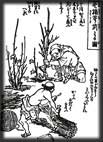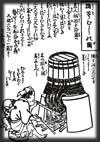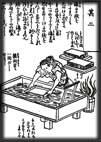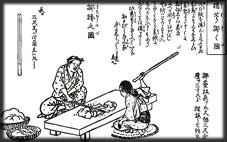Handmade
paper (tesuki washi) was invented in AD 105 by a Chinese official
named Cai Lun, and introduced to Japan in AD 610 by Doncho, a monk
from Korea. Sekishu washi, the special handmade paper of western Shimane
Prefecture, also has a long history over a thousand years long. The
name Sekishu washi comes from the fact that it was first produced
in Sekishu (present-day Iwami). It is also known as Sekishu-hanshi
(half-sheets from Sekishu) because of the cut of the paper.
Historically, the Sekishu washi appeared for the first time in records
from AD 905. In those records, Sekishu was one of 42 regions where
20 year-old men were obliged to deliver materials for the local speciality
washi as tax in kind. The name is probably much older, however, as
the 1798 book Kamisuki Chohoki (A Handy Guide to Papermaking), written
by Kunisaki Jihei, says that Kakinomoto Hitomaro, a leading official
in the area, taught people how to make washi sometime around AD 704-715.
If that is true, then not only is Sekishu an old name but, more importantly,
it shows that tesuki washi has been produced in the Iwami region for
about 1300 years.
Making Sekishu-hanshi was a side business for almost all families
in days of old. With the introduction of machinery, however, the 6377
families engaged in the business in 1894 decreased to 664 by 1940
and to 60 by 1965. There are now only 10 families making washi in
this region 6 in Misumi, 1 in Sakurae, and 3 in other localities.
Consequent to the drop in the number of washi makers, the manner of
business changed from a side job to a principal occupation. Those
now engaged in the work have found successors and carry out the traditional
techniques required for making this type of Japanese paper.
Sekishu-hanshi is made from processed bark fibers of three shrubsムkozo
(paper mulberry), mitsumata (Edgeworthia papyrifera), and gampi (Wikstroemia
sikokiana). A vegetable starch known as neri derived from the tororo-aoi
(Hibiscus manihot Medikus) is also added for kneading. After the initial
processing, the pulp solution is molded with bamboo or reed mats (su)
using a method called nagashi-suki. Sekishu-hanshi, which is the most
common washi, is produced from high quality kozo cultivated in this
region. The characteristics of this plant have helped make Sekishu-hanshi
famous as a fine, strong, and glossy paper, as indicated by the following
account. Because of its high quality, Sekishu-hanshi was once used
for account books by merchants in Osaka. In case of fire, the merchants
did not hesitate to throw the account books into a well to protect
the records from fire the merchants were not worried about the paper
being damaged by water.
In light of the unique traditional techniques and methods employed
to make Sekishu-hanshi by Sekishu-hanshi Craftsmens Association (Yasuichi
Kubota, President; 8 members), the paper was designated as an Important
Intangible Cultural Property in 1969.
In addition, the Sekishu techniques and methods used for Sekishu-hanshi
have been completely preserved by crafts people in Misumi Town. To
ensure even further improvement of the art, Sekishu Washi Cooperative
(hiroshi Nagami, Representative Chair; 7members) was established,
and in 1989 Sekishu washi was designated a traditional craft by the
Minister of Economy Trade and Industry.
Sekisyu Washi
Washi that has been chosen in the final selection process is cut to
make various paper products.
The technique of making Sekishu washi with kozo,mitsumata, and gampi
fibers is designated an Important Intangible Cultural Asset. These papers
are used to make such products as Japanese painting and calligraphy
paper, paper for dyed products, stationary, post cards, name cards,
notebooks, and traditional Japanese letter paper.
|

Kamisuki
Chohoki
Harvesting raw
materials

Kamisuki
Chohoki
Steaming branches
|
|
Sekishu kozo paper
The fibers of kozo (Broussonetia Kazinoki Sieb) are about 10 mm long.
By way of comparison, wood pulp fibers are only 1 mm long. Kozo fibers
are tough and mesh easily so that kozo paper retain its strength even
when crumpled or folded.
70% of Sekishu washi is made of kozo fibers.
Sekishu
mitsumata paper
The fibers of mitsumata (Edgeworthia chrysantha Lindle) are about 4
mm long.
They are slightly less strong than gampi and kozo, but they make a finer
and more flexible paper with a special glossy look.
Because of their smooth surface and gentle glossy appearance, mitusmata
is often the paper of choice for Japanese painting and calligraphy.
Sekishu
gampi paper
The fibers of gampi (Diplomorpha sikokiana Honda) average about 3 mm
in length.
The fibers are translucent, glossy and somewhat sticky, making gampi
paper glossy and smooth.
Even if they are put in a humid environment, they will not be damaged,
and they have an inherent resistance against insects.
|

Kamisuki
Chohoki
Making
the sheets

Kamisuki
Chohoki
Drying
|




